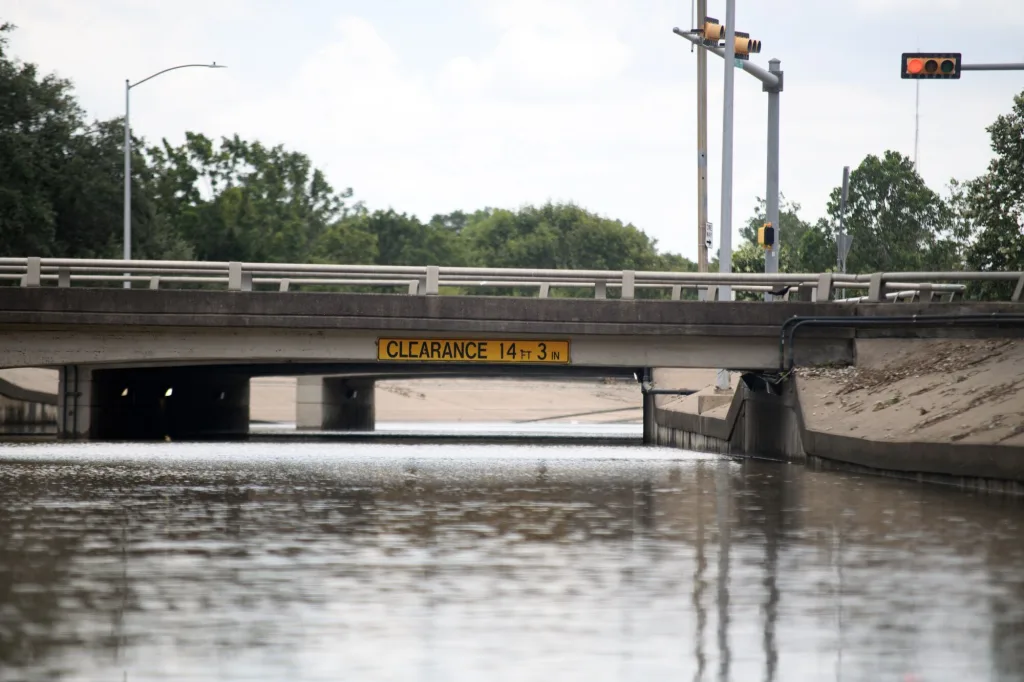Last Thursday, David Espinoza got in his 2011 Toyota Tacoma pickup truck to survey the damage in his neighborhood from Hurricane Beryl, which killed 11 people and dumped more than a foot of rain in some spots.
“It looks a bit like a battlefield. There’s a lot of trees here on the street,” says Espinoza, who is the co-director of community organizing for West Street Recovery, a community organization that assists in the wake of disasters in neighborhoods around northeast Houston.
Beryl made landfall as a Category 1 storm in Matagorda—about 85 miles southwest of Houston. But before that, it was briefly a Category 5 storm—the earliest ever in the Atlantic basin.
To no one’s surprise, the storm led to residential flooding, downed trees, and millions without power. As of Sunday, there are still at least 15% of affected customers without electricity.
But the biggest issue in some low-income Houston neighborhoods is the drainage system that quickly backs up when it rains and floods the neighborhoods. This isn’t a new problem—it’s been happening for decades—and yet city leaders are reluctant, or unable, to fix it.
“There was a failure in the drainage systems for a lot of folk. That meant that the water came back up into their houses.” Espinoza added.
While an issue for Houston at large, drainage problems are amplified in communities on the east side of the city where residents overwhelmingly rely on often polluted ditches for storm drainage. The northeast side has both a high concentration of Houston’s low income communities and a large proportion of these ditch drainage systems.

History keeps repeating itself
Unfortunately, this situation isn’t unusual in America’s fourth largest city, which is prone to disastrous tropical weather. During Hurricane Harvey, 150,000 homes flooded in Houston.
“We get some of the highest rainfall totals anywhere in the United States. We have clay soils, we have low slopes. That is a recipe for flood problems,” says Philip Bedient, professor of engineering at Rice University.
In 2001, Tropical Storm Allison dumped about 37 inches of rain, leading to massive flooding, including inside the emergency rooms of the city’s medical center. Highways were left as rivers for weeks. In 2008, Hurricane Ike brought as much as 18 inches of rain in some spots. Nine years later, Hurricane Harvey dumped so much rain that the National Weather Service had to add new colors to their rainfall total maps.
Severe weather like this comes with regular residential flooding. It’s not just tropical in nature. A little more than a month ago, the city was hit with a severe thunderstorm that brought 100+ mph winds and flash floods.
Since 2001, the city has required residents to maintain drainage ditches in front of their homes. That rule is particularly difficult for low-income residents, according to West Street Recovery, which lobbied for the city to revoke this rule. It ultimately agreed to last year.
A spokesperson for Houston Public Works told Fast Company that “Houston streets are designed to hold floodwaters to prevent them from entering private property and homes until the water can enter and flow through our drainage system.”
Houston Public Works will now be required to regrade ditches if they become unusable, but the residents will still be required to weed and keep the ditches free of obstruction like litter that could make it harder for stormwater to pass through.
“It reverses a policy that was not working well for the city,” then-Mayor Sylvester Turner said in a city council session.
Despite the change, the daily maintenance is still a burden on residents. A third of all open air drainages are in neighborhoods where the majority of its residents live in poverty.
A well-known issue
The city has known about this problem for years. In 2015, the city of Houston commissioned a report showing that open air ditches that aren’t well maintained “do not have the same capacity as streets with curbs and gutters to decrease the instances of flooding.”
The new initiative will take five years to fully take effect. Thus far, it has prioritized elderly and disabled residents who don’t have the physical capabilities to tend to the ditches outside their homes. West Street Recovery worked with the city to identify who those people are and where they live.
“Obviously it’s a lot harder for them to clean out or maintain ditches to the degree that they need to be maintained,” Espinoza said.
To the city’s credit, there has been some progress in the past few years for broader improvements. In 2018, Houston City Council announced a rule that new homes built in the city need to be two feet above the 500-year floodplain.
As for water removal, Bedient says the city is looking to add detention ponds quickly. That helps Houstonians who live on the western side of the city.
He says that for the eastern side, where the overwhelming majority of ditches are located, there are talks about a robust tunnel system that would move stormwater away from city streets.
But the project could cost around $30 billion to build and could take decades to complete. The inherent bureaucracy of local government means that substantive long-term action could still be years away, leaving ample time for more floods to repeatedly disrupt lives.
“My concern with the tunnel system is that it’s just going to take a very, very long time. It is also very expensive,” Bedient said. “I just don’t know where that’s all going to land.”